
If your donation page gets lots of visitors but very few actual donations, you’re in good company. That’s the situation that most nonprofit website managers are facing.
Google Analytics will show hundreds of pageviews for your donate page, but your fundraising database shows just a few online donations.
So, what’s a website manager to do?
Here’s what I recommend:
Don’t send everyone to the donate page. Only send the right people to the donate page.
When you send everyone to the donate page, you’re missing out on the opportunity to win your potential donor’s heart and mind.
When you only send the right people to the donate page, you’re targeting people who are ready for you to win them over!
I have 5 suggestions that you can start implement right away. The list below is sorted in order of greatest opportunity. So start with the first item and work your way down!
1. Show them a popup… but wait 10 seconds
If you hate popups, then pay attention: popups work.
I’ve tested them on nonprofit sites and on my site, and they just work.
Here’s the key: Don’t show the popup as soon as a visitor arrives on your site.
Delay the popup for at least 10 seconds. Now when the popup appears, it will only target visitors who are invested in their visit and interested in your organization.
Need more tips about popups? Check out my article: Evil Popups for the Greater Good
2. Add a donate button on popular, relevant pages… in a relevant way
See what I did at the end of item #1? I linked to another article that might be helpful to you.
Do the same with the popular pages on your site. Add a donate button (or just a text link, whatever works!) in a way that makes sense for the reader..
For example, your executive director’s profile is usually one of the most popular pages on your site. Add a button or a link to your donate page, along with some copy like… “Would you like to support Anna Cruz’s life-changing work on behalf of women and children? Make a donation in her honor!”.
Pro-tip: Popular pages on most nonprofit websites are About, Staff/Leadership, Contact and Services..
Need help creating a donate button? Check out my training: How to Create the Perfect Donate Button
3. Send an email appeal to non-donors… who have opened your last 6 messages
I learned this strategy from my own experiments with my email marketing platform, MailChimp.
Subscribers to my list will often open months and months worth of messages from me before they engage with me on a website project or for a digital training.
If someone on your list is consistently opening up your email messages but still hasn’t donated, it’s because you either haven’t asked at the right time or in the right way.
Test drive a new email appeal just for non-donor peeps on your email list that have opened up your last six messages (or about three months worth of email messages, depending on how often you send).
If your email marketing tool doesn’t let you target this group of subscribers, check out my review of MailChimp in Successful Email Marketing on a Budget.
4. Send an email appeal to people who opened your last year-end appeal… but didn’t click
Someone who opened your email appeal at year end but didn’t click to the donate page was almost there, but they needed an additional reason to give.
Send them a special email message thanking them for being a part of your community. Email subscribers are like gold! Love them up.
Then invite them to support a specific, time sensitive campaign.
We don’t know the exact reason why this donor didn’t give at year end, but we do know that deadlines are an important reason why many of us finally take action (me included!)
5. Send all your social media visitors to your website… via a special landing page just for them
Don’t send your social media peeps to the homepage or the same donate page as everyone else.
Someone who follows you on social media is already a fan. Acknowledge and build upon that affinity by sending your social media fans to a special donate page, just for them.
Thank them for their support. Use the opportunity to tell them more about your work, more than what you can fit in a tweet or a FB post.
Invite them to become a donor. You might even create a special social media fundraising campaign or challenge.

Was this article useful to you?
Join my email list! You’ll receive more helpful resources just like this one, every two weeks. You’ll also be the first to know when there’s a new opportunity to work with me! Just scroll down and enter your email address.




